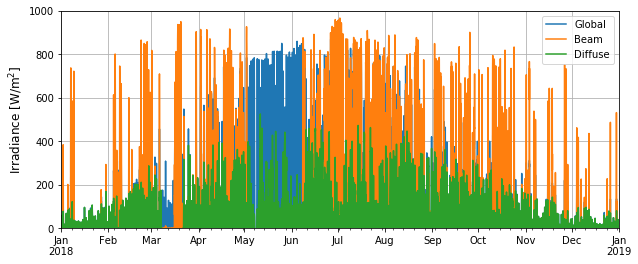6th International Conference Energy & Meteorology: Abstract Submission
Gap filling of long-term solar radiation measurements in Denmark (787)
Beam, global and diffuse solar radiation have been measured at the Technical University of Denmark (DTU) since 1989. It was the only place in Denmark that solar radiation was measured, until 2001 when the Danish Meteorological Institute (DMI) began to measure global radiation at 28 sites around the country. The measurements from DTU, therefore, represents the only long-term 3-component radiation measurements in Denmark. As with any meteorological station, the time series has numerous gaps of missing data, spanning from a few minutes to multiple days. In Figure 1 the hourly average values of solar irradiance are shown for 2018, where it for example is can be seen that there is a long gap in diffuse irradiance measurements in March and a gap in beam irradiance in May.
In order to assess the long-term trends in solar irradiance it is necessary to take data gaps into account. For this, there exists a number of methods, ranging in complexity and accuracy. In order to determine the most suitable method and the impact of each methods, the long-term solar irradiance time series from DTU is gap-filled using a range of different gap fillings methods. The results of each method is compared, where the primary focus is on monthly values, but also the impact on the simulated thermal output of a standard flat plate collector is determined for each of the methods.

Figure 1: Solar irradiance for 2018 measured at the Technical University of Denmark.